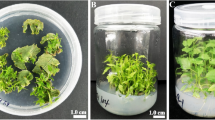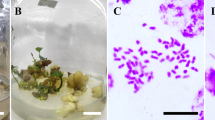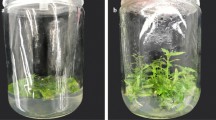Abstract
Tetraploid black locust (Robinia pseudoacacia L.) has advantages over diploid varieties in growth and stress resistance. Previous studies had shown that tetraploid black locust can be induced only by treating shoot tips of the germinating seeds with colchicine. In order to establish a simpler and more efficient tetraploid induction method in black locust, we induced tetraploid plants by treating the hypocotyls from in vitro–grown seedlings with different concentrations of colchicine, and then provided a method for tetraploid identification based on stomatal size and density in this study. The highest induction efficiency was 53.33% by treating hypocotyl explants with 70 mg·L−1 colchicine for 2 d. Tetraploid black locust was significantly different from diploid in morphological characteristics. Leaf area, leaf thickness, chlorophyll content, stomatal length, and stomatal width were greater in tetraploid plants than in diploid plants, whereas the opposite was true for leaf aspect ratio, stomatal index, and stomatal density. The differences in stomatal size and density between diploid and tetraploid were nearly two times; therefore, size and density of stomata can be used as a stable and distinct marker to rapidly screen tetraploids. The results of this study suggested that the hypocotyl was an ideal material to induce tetraploid black locust in vitro and confirmed that stomatal size and density could be an effective and reliable marker to identify ploidy level in black locust.




Similar content being viewed by others
References
Bylesjö M, Segura V, Soolanayakanahally RY, Rae AM, Trygg J, Gustafsson P, Jansson S, Street NR (2008) LAMINA: a tool for rapid quantification of leaf size and shape parameters. BMC Plant Biol 8:82–90
Cai X, Kang XY (2011) In vitro tetraploid induction from leaf explants of Populus pseudo-simonii Kitag. Plant Cell Rep 30:1771–1778
Cao Q, Zhang X, Gao X, Wang L, Jia G (2018) Effects of ploidy level on the cellular, photochemical and photosynthetic characteristics in Lilium FO hybrids. Plant Physiol Biochem 133:50–56
Carbajal EM, Zuleta MC, Swayzer L, Schwartz BM, Chavarro MC, Ballen-Taborda AC, Milla-Lewis SR (2019) Development of colchicine-induced tetraploid St. Augustinegrass (Stenotaphrum secundatum) lines. Plant Breed 138:1–9
Chauvin JE, Label A, Kermarrec MP (2005) In vitro chromosome-doubling in tulip (Tulipa gesneriana L.). J Hortic Sci Biotechnol 80:693–698
Chen CH, Goeden-Kallemeyn YC (1979) In vitro induction of tetraploid plants from colchicine-treated diploid daylily callus. Euphytica 28:705–709
Ewald D, Ulrich K, Naujoks G, Schröder MB (2009) Induction of tetraploid poplar and black locust plants using colchicine: chloroplast number as an early marker for selecting polyploids in vitro. Plant Cell Tiss Org Cult 99:353–357
Gallone A, Hunter A, Douglas GC (2014) Polyploid induction in vitro using colchicine and oryzalin on Hebe ‘Oratia Beauty’: production and characterization of the vegetative traits. Sci Hortic 179:59–66
Gu XF, Yang AF, Meng H, Zhang JR (2005) In vitro induction of tetraploid plants from diploid Zizyphus jujuba, Mill. cv. Zhanhua. Plant Cell Rep 24:671–676
Javadian N, Karimzadeh G, Sharifi M, Moieni A, Behmanesh M (2017) In vitro polyploidy induction: changes in morphology, podophyllotoxin biosynthesis, and expression of the related genes in Linum album (Linaceae). Planta 245:1165–1178
Kermani MJ, Sarasan V, Roberts AV, Yokoya K, Wentworth J, Sieber VK (2003) Oryzalin-induced chromosome doubling in Rosa and its effect on plant morphology and pollen viability. Theor Appl Genet 107:1195–1200
Khazaei H, Monneveux P, Hongbo S, Mohammady S (2010) Variation for stomatal characteristics and water use efficiency among diploid, tetraploid and hexaploid iranian wheat landraces. Genet Resour Crop Evol 57:307–314
Kim CS, Lee SK (1972) Studies on a tetraploid of Robinia pseudoacacia L. selected in the planted forest. J Korean Soc Forest Sci 14:39–44
Liu G, Li Z, Bao M (2007) Colchicine-induced chromosome doubling in Platanus acerifolia and its effect on plant morphology. Euphytica 157:145–154
Mallaya NP, Ravishankar GA (2013) In vitro propagation and genetic fidelity study of plant regenerated from inverted hypocotyl explants of eggplant (Solanum melongena L.) cv. Arka Shirish. 3 Biotech 3:45–52
Murashige T, Skoog F (1962) A revised medium for rapid growth and bio assays with tobacco tissue cultures. Physiol Plant 15:473–497
Murch SJ, Saxena PK (2001) Molecular fate of thidiazuron and its effects on auxin transport in hypocotyls tissues of Pelargonium × hortorum Bailey. Plant Growth Regul 35:269–275
Nagar DS, Jha SK, Jani J (2015) Direct adventitious shoot bud formation on hypocotyls explants in Millettia pinnata (L.) Panigrahi- a biodiesel producing medicinal tree species. Physiol Mol Biol Plants 21:287–292
Neto VBDP, Mota TRD, Otoni WC (2003) Direct organogenesis from hypocotyl-derived explants of annatto (Bixa orellana). Plant Cell Tiss Org Cult 75:159–167
Nicolescu V, Hernea C, Bakti B, Keserű Z, Antal B, Rédei K (2018) Black locust (Robinia pseudoacacia L.) as a multi-purpose tree species in Hungary and Romania: a review. J For Res 29:1449–1463
Parisod C, Holderegger R, Brochmann C (2010) Evolutionary consequences of autopolyploidy. New Phytol 186:5–17
Sánchez-Bravo J, Ortuño AM, Botía JM, Acosta M, Sabater F (1992) The decrease in auxin polar transport down the lupin hypocotyl could produce the indole-3-acetic acid distribution responsible for the elongation growth pattern. Plant Physiol 100:108–114
Souza RRD, Paiva PDDO, Silva RRD, Silva DPCD, Reis MVD, Paiva R (2019) Morphogenetic potential of different sources of explants for efficient in vitro regeneration of Genipa sp. Plant Cell Tiss Org Cult 136:153–160
Stevens AV, Nicotra AB, Godfree RC, Guja LK (2020) Polyploidy affects the seed, dormancy and seedling characteristics of a perennial grass, conferring an advantage in stressful climates. Plant Biol 22:500–513
Straker KC, Quinn LD, Voigt TB, Lee DK, Kling GJ (2015) Black locust as a bioenergy feedstock: a review. BioEnergy Res 8:1117–1135
Wang LJ, Sheng MY, Wen PC, Du JY (2017) Morphological, physiological, cytological and phytochemical studies in diploid and colchicine-induced tetraploid plants of Fagopyrum tataricum (L.) Gaertn. Bot Stud 58:2–13
Wang XL, Zhou JX, Yu MD, Li ZG, Jin XY, Li QY (2011) Highly efficient plant regeneration and in vitro polyploid induction using hypocotyl explants from diploid mulberry (Morus Multicaulis Poir.). In Vitro Cell Dev Biol - Plant 47:434–440
Wang Z, Wang M, Liu L, Meng F (2013) Physiological and proteomic responses of diploid and tetraploid black locust (Robinia pseudoacacia L.) subjected to salt stress. Int J Mol Sci 14:20325
Widoretno W (2016) In vitro induction and characterization of tetraploid Patchouli (Pogostemon cablin Benth.) plant. Plant Cell Tiss Org Cult 125:261–267
Wu J, Sang Y, Zhou Q, Zhang P (2020) Colchicine in vitro tetraploid induction of Populus hopeiensis from leaf blades. Plant Cell Tiss Org Cult 141:339–349
Yan HJ, Xiong Y, Zhang HY, He ML (2016) In vitro induction and morphological characteristics of octoploid plants in Pogostemon cablin. Breed Sci 66:169–174
Zahumenická P, Fernández E, Šedivá J, Žiarovská J, Ros-Santaella JL, Martínez-Fernández D, Russo D, Milella L (2018) Morphological, physiological and genomic comparisons between diploids and induced tetraploids in Anemone sylvestris L. Plant Cell Tiss Org Cult 132:317–327
Zhang J, Zhang M, Deng X (2007) Obtaining autotetraploids in vitro at a high frequency in Citrus sinensis. Plant Cell Tiss Org Cult 89:211–216
Acknowledgments
We thank the glasshouse staff for the management of plants, and other students in our lab for their friendly help.
Funding
This work was funded by the National Nature Science Foundation of China (31570677), the National Key R&D Program of China (2017YFD0600503), and the State Forestry Administration of science and technology development center project (XPC-2015-3).
Author information
Authors and Affiliations
Contributions
YL, XL, and YR conceived and designed research. YF, QG, and LD conducted experiments. XL and ZZ analyzed data and wrote the manuscript. YS contributed stock plants. All authors have read and approved the final manuscript.
Corresponding author
Ethics declarations
Competing interests
The authors declare that they have no competing interests.
Additional information
Editor: Bin Tian
Electronic supplementary material
ESM 1
(XLSX 10 kb)
Rights and permissions
About this article
Cite this article
Li, X., Zhang, Z., Ren, Y. et al. Induction and early identification of tetraploid black locust by hypocotyl in vitro. In Vitro Cell.Dev.Biol.-Plant 57, 372–379 (2021). https://doi.org/10.1007/s11627-020-10133-5
Received:
Accepted:
Published:
Issue Date:
DOI: https://doi.org/10.1007/s11627-020-10133-5




